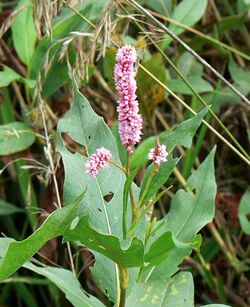Biology:Persicaria bicornis
| Persicaria bicornis | |
|---|---|

| |
| Scientific classification | |
| Kingdom: | Plantae |
| Clade: | Tracheophytes |
| Clade: | Angiosperms |
| Clade: | Eudicots |
| Order: | Caryophyllales |
| Family: | Polygonaceae |
| Genus: | Persicaria |
| Species: | P. bicornis
|
| Binomial name | |
| Persicaria bicornis (Raf.) Nieuwl. 1914
| |
| Synonyms[1] | |
| |
Persicaria bicornis is a North American species of flowering plant in the buckwheat family (Polygonaceae). The common name is pink smartweed. It is native to the central and southwestern United States from northern Texas west to Arizona, east to Louisiana, and north as far as eastern Wyoming, South Dakota, Iowa, and Illinois.[3][4]
Description
Persicaria bicornis is an annual herb that grows up to 180 cm (5.9 ft) tall. It has lanceolate leaves up to 18 cm (7 in) long and groups of small pink flowers with 5 pink tepals. Its pink flowers contain 6-8 stamens with pink or red anthers. These flowers contain 1 compound pistil with 2-3 styles coming out of the base of the flower.[4][5] The blooms appear to be fringed, and its heterostylous flowers are positioned very closely together.[6] Persicaria bicornis has leaf blades that are more narrow than P. pensylvanica, which helps to distinguish the two.[7]
Distribution and habitat
This species can be found in North America: Arkansas, Colorado, Illinois, Louisiana, Missouri, and Texas amongst other places. It can be found in disturbed places such as moist ditches, and on the shorelines of ponds and reservoirs.[5] Persicaria bicornis typically grows from June to October.[5]
Uses
There are currently no known human uses for this particular species.[8][9][10]
References
- ↑ The Plant List, Persicaria bicornis (Raf.) Nieuwl.
- ↑ "Catalogue of Life: Persicaria bicornis" (Raf.) Nieuwl.
- ↑ Biota of North America Program 2014 county distribution map
- ↑ 4.0 4.1 Flora of North America, Persicaria bicornis (Rafinesque) Nieuwland, 1914. Pink smartweed
- ↑ 5.0 5.1 5.2 "Persicaria bicornis in Flora of North America @ efloras.org". http://www.efloras.org/florataxon.aspx?flora_id=1&taxon_id=250060696.
- ↑ "PlantFiles Pictures: Persicaria Species, Pink Smartweed (Persicaria bicornis) by htop" (in en). https://davesgarden.com/guides/pf/showimage/100855/.
- ↑ "Persicaria bicornis in Flora of North America @ efloras.org". http://www.efloras.org/florataxon.aspx?flora_id=1&taxon_id=250060696.
- ↑ Zhang, Yin; Xu, Hualin; Chen, Hui; Wang, Fei; Huai, Huyin (2014-10-15). "Diversity of wetland plants used traditionally in China: a literature review" (in en). Journal of Ethnobiology and Ethnomedicine 10 (1): 72. doi:10.1186/1746-4269-10-72. ISSN 1746-4269. PMID 25318542.
- ↑ "Persicaria lapathifolia, Curlytop Knotweed, Southwest Desert Flora". http://southwestdesertflora.com/WebsiteFolders/All_Species/Polygonaceae/Persicaria%20lapathifolia,%20Curlytop%20Knotweed.html.
- ↑ "Smartweed: Uses, Side Effects, Interactions, Dosage, and Warning" (in en). https://www.webmd.com/vitamins/ai/ingredientmono-129/smartweed.
Wikidata ☰ Q15594808 entry
 |

